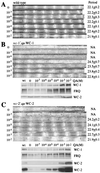Interlocked feedback loops contribute to the robustness of the Neurospora circadian clock
- PMID: 11416214
- PMCID: PMC34682
- DOI: 10.1073/pnas.121170298
Interlocked feedback loops contribute to the robustness of the Neurospora circadian clock
Abstract
Interlocked feedback loops may represent a common feature among the regulatory systems controlling circadian rhythms. The Neurospora circadian feedback loops involve white collar-1 (wc-1), wc-2, and frequency (frq) genes. We show that WC-1 and WC-2 proteins activate the transcription of frq gene, whereas FRQ protein plays dual roles: repressing its own transcription, probably by interacting with the WC-1/WC-2 complex, and activating the expression of both WC proteins. Thus, they form two interlocked feedback loops: one negative and one positive. We establish the physiological significance of the interlocked positive feedback loops by showing that the levels of WC-1 and WC-2 determine the robustness and stability of the clock. Our data demonstrate that with WC-1 being the limiting factor in the WC-1/WC-2 complex, the greater the levels of WC-1 and WC-2, the higher the level of the FRQ oscillation and the more robust the overt rhythms. Our data also show that, despite considerable changes in the levels of WC-1, WC-2, and FRQ, the period of the clock has been limited to a small range, suggesting that the interlocked circadian feedback loops are also important for determining the circadian period length of the clock.
Figures






References
Publication types
MeSH terms
Substances
Grants and funding
LinkOut - more resources
Full Text Sources

